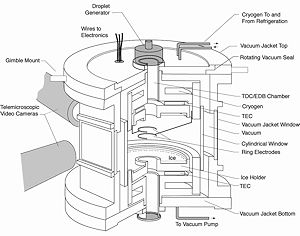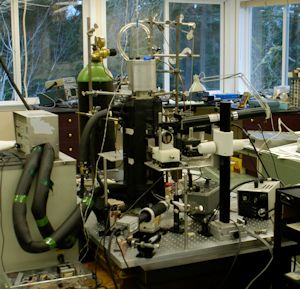ONGOING PROJECTS
Ice Nucleation:
In our laboratory we study ice nucleation by observing the freezing of supercooled droplets using various methods. Some experiments are done using free-fall inside a freezing tube which makes possible the observation of the freezing process with high repetition rates and away from contamination, particle-particle interactions, and the possible influence of substrates. Experiments range from studying the activity of sea ice bacteria, comparing the ice nucleating properties of sea-ice bacteria and other mesophylic bacteria, to measuring the frozen fraction curves of homogeneous droplets containing common tropospheric aqueous solutions.
|
Light Scattering Properties of Ice Particles:
Uncertainty in the light scattering properties of clouds is one of the major sources of error in cloud and climate models. We are interested to measure the differential light-scattering cross section and phase functions of single ice particles with the various shapes found in ice clouds. To date we have determined the phase function for hexagonal-hexagonal prismatic ice particles for a range of aspect ratios and particle orientations. Future experiments will explore the non-prismatic ice particle shapes which commonly are common in upper tropospheric clouds.
|
Sap Crystal morphology and growth mechanism:
We have been looking at ice crystal formation on alder and maple tree surfaces. This is an ongoing study to determine how sap crystal morphology depends on plant type. It appears that frost damage on many plants is caused by the growth of sap crystals. Comparisons between the crystals found on North American plants and those observed on Dock family plants observed in Ladakh, India show the influence of plant anatomy on crystal shape. Our goal is to better understand the growth rates and formation mechanism of these crystals. We also attempt to determine the extent to which these processes are responsible for frost damage in some species of plants.
|
|
Laucks Foundation Research
Laucks Foundation Research is a small non-profit research institute focused on developing table-top scale instruments for atmospheric physics research. Our current interests are in the fundamental processes associated with the formation of ice and clouds.
The issues central to our research are:
- the role of biogenic material and bacteria in ice and cloud formation
- the dependence of water vapor pressure on the chemistry of aqueous cloud droplets
- the dominant ice nucleation mode in the upper tropospheric clouds
- the growth rate of ice particles and its dependence on ice nucleation mode
- the determining factors for tropospheric ice particle shape
- the light scattering properties of ice particles
- the microphysics of thunderstorm electrification
- the physical and chemical properties near the surfaces of ice and aqueous solutions.
LF Research takes an experimental approach to solving these processes by developing new table-top scale instruments and high-precision methods. We are particularly concerned with effectively removing potential contamination and surface effects that have been systematic problems in previous measurements. The broader impact of this work is to improve the precision of cloud and climate models in describing the influence of clouds on the radiative properties of the Earth. Global climate change may greatly impact society, making it crucial that policy makers have the most accurate possible assessments from climate models.
RESEARCH FACILITIES AND EQUIPMENT
SPACE
The Laucks Foundation research facility has approximately 2000 square feet of laboratory and office space. The laboratory is equipped with a variety of instrumentation including a low-temperature electrodynamic balance for growth rate measurements and habit observations, a droplet free-fall freezing tube apparatus for nucleation studies, and an optical cryostat for observing the freezing of ice surfaces. The laboratory is equipped with optical tables for vibration isolation, electronics and computers for temperature, pressure and humidity monitoring, and CCD video cameras with telemicroscopic lenses for imaging.
|

|

|
LOW TEMPERATURE EDB
The low temperature electrodynamic balance, capable of observing crystal growth and morphology changes, uses an internally mounted diffusion chamber to set the temperature and supersaturation conditions near the levitated crystal to those that simulate cirrus conditions. A ULT-80 temperature-controlled bath/circulator unit provides cooling down to -60 C. The levitation electronics and temperature and humidity monitoring electronics are computer interfaced via Labview. Imaging for the EDB experiments is done using two digital CCD video cameras with telemicroscopic lenses.
|
FREEZING TUBE
The freezing tube with droplet-on-demand system is available for assessment of ice nucleation frozen fraction curves from both homogeneous and heterogeneous droplets along with light scattering and droplet imaging of freezing. The optical cryostat contains a sample stage cooled with thermoelectric coolers both for temperature and humidity control.
|

|

|
SHOP
Laucks Foundation Research also has a 1600 square foot machine and electronics shop on site. Our on-site machine shop is well equipped with lathe, CNC milling machine, plasma cutter, and welding equipment. Our on-site electronics shop is available to assist with instrumentation development. A cold room is also available for use.
|
|

